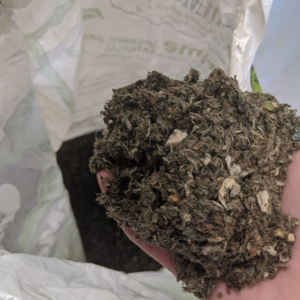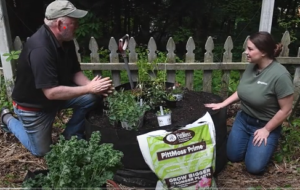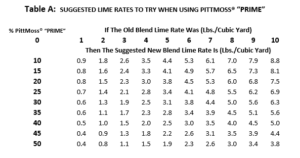PittMoss® Prime is an organic, OMRI listed soil amendment made from recycled paper. The material is derived from non-toxic, recycled, and natural inputs that have been re-engineered to optimize air and water holding capacity while ensuring efficient delivery of nutrients to the plant and providing an excellent environment for beneficial microbial growth. This up-cycled media consists of paper fiber with small amounts of organic bark and compost, perfect for improving native soil conditions, composting, mulching, and using as worm bedding. PittMoss® Prime is a very clean media with exceptionally low heavy metal levels, so you can take pride in good stewardship of the environment and your health (see our Scientific Studies for more).

Sustainable Growing with Prime
PittMoss fibers are manufactured in the United States, supporting green manufacturing. All of the paper and cardboard components are obtained from local recycling facilities and hand sorted at our facility in Ambridge, PA before being fiberized by our custom, patent-pending machinery. The end product reduces runoff with enhanced nutrient absorption and superior moisture wicking, so growers can be confident in PittMoss® Prime’s optimization of applied resources. The carbon-rich nature of the material also encourages a living soil environment with more labile carbon for microbes to feed on. PittMoss® Prime’s physical structure (in reference to the aeration provided by internal and external pore sizes) makes for superior root development.
Superior Performance
Improving Soil Structure
Some growers use PittMoss® Prime with their existing compost, incorporating it at rates above 20% for improved physical structure. Prime can also be used as a compost starter as a substantial source of carbon. The material absorbs and holds water like a sponge, extending the time between watering and dramatically improving plant life in stressed environments. Blend rates from 20 to 50% have shown superior results, extending the life of the plant. PittMoss® Prime can be incorporated with finer textured peats to improve structure with better aeration and usable water. The fiber structure and water loving (hydrophilic) properties of PittMoss® Prime make blends absorb, translocate, and release water more readily. Most often, no wetting agent is required in blends containing 30% or more PittMoss® Prime.
Maximizing Nutrient Availability
By blending PittMoss® Prime into a growing media, the user should reduce the rates of soluble fertilizer application to the crops. Avoid blending in high ammoniacal and urea containing fertilizers. Once PittMoss® Prime is charged with a balance of nutrients, it then optimizes the delivery of those nutrients to the plant by reducing nutrient tie-up and leaching. Because of accelerated root development, incorporating a moderate to high level of a balanced starter charge is recommended. (See Table B for suggested rates.) Once fully charged with nutrients, the soluble fertilizer application rates should be reduced (75 to 100 ppm N in bedding and potted plants). Avoid applying fertilizers containing high percentages of ammonium or urea additives. With the proper starter charge and lower application rates, leaching can be eliminated, thus reducing fertilizer costs and environmental nutrient run-off. Consumers will benefit from the supply of nutrients held in the container or “root ball” of their purchased plants.
Proper pH in your blend is essential to deliver the best results. PittMoss® Prime has a near neutral pH and tends toward the pH of the materials with which it is blended. Since most crops do best at slightly acidic pH (5.5 to 6.5), PittMoss® Prime is best combined with lower pH components. The more acidic components help to pull the pH of the PittMoss® Prime down to the 5.5 to 6.5 range. Most often it is best to reduce the amount of lime applied when using PittMoss® Prime. A good rule of thumb is to reduce the lime rate by the percentage of materials replaced by PittMoss® Prime. Table A provides a chart showing suggested changes in lime rates. (Example: If you replace the perlite, which was 20% of the blend, and replace 20% of the sphagnum by adding back 40% PittMoss® Prime, then you need to reduce the lime rate by 20%. If you applied 6 lbs. lime per cubic yard of mix you would now apply only 80% of that or about 4.8 lbs.) It is always recommended that blends be tested after they have equilibrated, usually requiring 2 to 3 weeks of moist incubation on the bench or in production.
Optimizing Soil Biology
The engineered fibers in PittMoss® Prime provide the most possible sites with the right environment for beneficial microbial activity. Biological activity and naturally beneficial microbial systems thrive in the more aerobic structure of PittMoss® Prime. The optimal porosity and high cellulose surface area of the PittMoss fibers appear to help accelerate development of beneficial aerobic microorganisms. The supply of natural organic food stuff for the microbes and the plant promote strong development. Some have suggested that biological inoculum can thrive aggressively in PittMoss® Prime. Growers have reported more rapid and extensive development of beneficial microbial populations. Expect natural and inoculated blends with 25% or more PittMoss® Prime to show enhanced beneficial microbial activity.

Handling and Storage
The engineered fibers of PittMoss® Prime handle similar to other media components. PittMoss® Prime flows and blends well in most equipment. It can be fluffed up more than most components, but when blended, it will re-compact to its optimal state. The material tends to expand or fluff up more when dry than when moist, and growers suggest applying more compaction when filling containers. The hydrophilic properties of the product make it effective in absorbing excess water from excessively moist components. Note that excessive water in PittMoss® Prime can greatly limit its ability to blend uniformly and can cause clumping and balling of the fibers. If you are unsure when to water, we recommend sticking your index finger a couple inches down into the soil to see if the material needs re-wetted. Oftentimes the top layer of PittMoss will appear dry, but that is due to the material’s good drainage. As with any growing media, over-processing damages the structure of the blend. The PittMoss® Prime fibers are very resilient, but if over-processed when wet, the effectiveness of the structure can be reduced.
Containers are best filled with moistened substrate. Moisten the blend until it makes a ball when squeezed and then crumbles when disturbed. Compaction when filling containers should be a little greater when using PittMoss® Prime due to the very high porosity resulting from fluffing. This will ensure full containers when watered to saturation.
Exposure to air and drying in PittMoss® Prime is less problematic than with most blends due to the easy rewetting of the hydrophilic fibers. However, storage of moistened blends in deep piles or large bins for more than a few days is not recommended. PittMoss® Prime blends will compost like most moistened and nutrient rich blends. However, the biological activity appears to be greater in PittMoss® Prime due to the optimal nature of the fibers (see Optimizing Biology above). While composting of the substrate is not necessarily bad, ten days in a deep pile appears to be the limit for preventing excessive composting activity.
Suggested Liquid Nutrient Applications For Organic Production When Using PittMoss® Prime


Leave a reply
You must be logged in to post a comment.